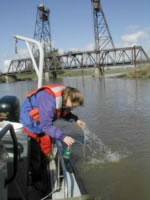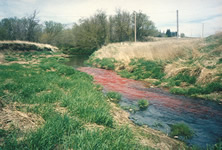|
A key objective of the Toxic Substances Hydrology (Toxics) Program is to understand the physical, chemical,
and biological processes that control contaminant transport in surface water. Many Toxics Program scientists
participate in multidisciplinary investigations of the reactive and non-reactive transport of contaminants in
rivers and streams. A part of many of these investigations is to develop simulation models to predict contaminant
transport in streams. Environmental professionals can use the results of these investigations to design better
restoration plans for rivers and streams impacted by contamination from many different sources. The information
presented on this page cuts across lines drawn by individual investigations and
projects so that information on contaminant transport surface-water can be presented in one place.
Investigations and Research Activities
- Watershed Contamination from Hard-Rock Mining
- Pesticide Contamination in Varied Pesticide-Use
Settings
- In-Stream Processes that Control the Fate of
Emerging Contaminants
- Antibiotics in the Spring Flush that Occurs in
Midwestern Streams
- Biotransformation of Tributyltin in Freshwater River-Bed
Sediments
- Investigations of Emerging Contaminants from
Wastewater Treatment Plants
- USGS Surface-water quality and flow
Modeling Interest Group (SMIG)
- Transient Storage Reader 1, The
Transient Storage Concept, Reading List on Applications for Stream Solute Transport in the Context of
Stream-Catchment Connections
- Transient Storage Reader 2, The
Transient Storage Concept, Comprehensive Reading List on Applications for Stream Solute Transport with
Selected References in the Context of Stream-Catchment Connections, Hyporheic Exchange Flows, and
Reactive Solute Transport
- Mining-Related Stream Transport Simulation Reader, A Reading List on Applications of OTEQ, OTIS, and Transient Storage for Metals, Cations, and Acidic Streams
- Coupled Transport and Geochemical Processes
Determining the Fate of Chemicals in Surface Waters
- Solute Transport Involving Biological
Processes in Surface Waters
- Benthic Fluxes of Metals and
Nutrients
- Diel Cycling of Trace Metals in Streams
- Isotope Tracers of Biogeochemical and
Hydrologic Processes
- Hydrologic and Chemical Interactions between
Surface Water and Ground Water
- Biotic Interface with Fluvial Transport
Processes Associated with Dissolved Solutes in Transport
- Toxics Program - Metal Release, Transport,
and Attenuation in Mined Areas: Mechanisms and Implications for Remediation and Land-Use Strategies
- Modeling Crosscutting Topic
Fact Sheets
|

Water sampling to assess the transport of pesticides in the
San Joaquin River, CA
(Click on Image for a Larger Version)
Headlines
Bibliography
New Publications
Upcoming Publications
- Understanding the occurrence and transport of current-use pesticides in the San Francisco Estuary Watershed: Kuivila, K.M., and Hladik, M.L., San Francisco Estuary and Watershed Science (IN PRESS).
- An Eulerian-Lagrangian numerical scheme for simulating streams with advection, dispersion, and transient storage in streams and a comparison of numerical methods: Cox, T.J., and Runkel, R.L., Journal of Environmental Engineering (IN PRESS).
- Interpretation of a transient storage model of stream solute transport applied to overlapping spatial scales: Gooseff, M.N., Briggs, M.A., Bencala, K.E., McGlynn, B.L., and Scott, D.T., Limnology and Oceanography--Methods (IN PRESS).
- One-dimensional transport with equilibrium chemistry (OTEQ)--A reactive transport model for streams and rivers: Runkel, R.L., U.S. Geological Survey Techniques and Methods book 6, chapter B6 (IN PRESS).
Newly Published
- Understanding the occurrence and transport of current-use pesticides in the San Francisco Estuary watershed: Kuivila, K.M., and Hladik, M.L., 2008, San Francisco Estuary and Watershed Science, v. 6, no. 3, Article 2.
- Mercury and organic carbon dynamics during runoff episodes from a northeastern USA watershed: Schuster, P., Shanley, J., Marvin-Dipasquale, M., Reddy, M., Aiken, G., Roth, D., Taylor, H., Krabbenhoft, D., and DeWild, J., 2008, Water, Air, and Soil Pollution, v. 187, no. 1, p. 89-108, doi:10.1007/s11270-007-9500-3.
- Metals fate and transport modelling in streams and watersheds--State of the science and USEPA workshop review: Caruso, B.S., Cox, T.J., Runkel, R.L., Velleux, M.L., Bencala, K.E., Nordstrom, D.K., Julien, P.Y., Butler, B.A., Alpers, C.N., Marion, A., and Smith, K.S., 2008, Hydrologic Processes, v. 22, no. 19, p. 4011-4021, doi:10.1002/hyp.7114.

Dye was used in a study of the transport and degradation of atrazine (a herbicide) in
Roberts Creek, IA, as part of a study of fate and occurrence of
herbicides in the Midwest corn belt. The dye helped scientists determine the transport time of water as it
moved through the study reach of the stream. The red color in the stream is rhodamine WT dye
(Click on Image for a Larger Version)
|